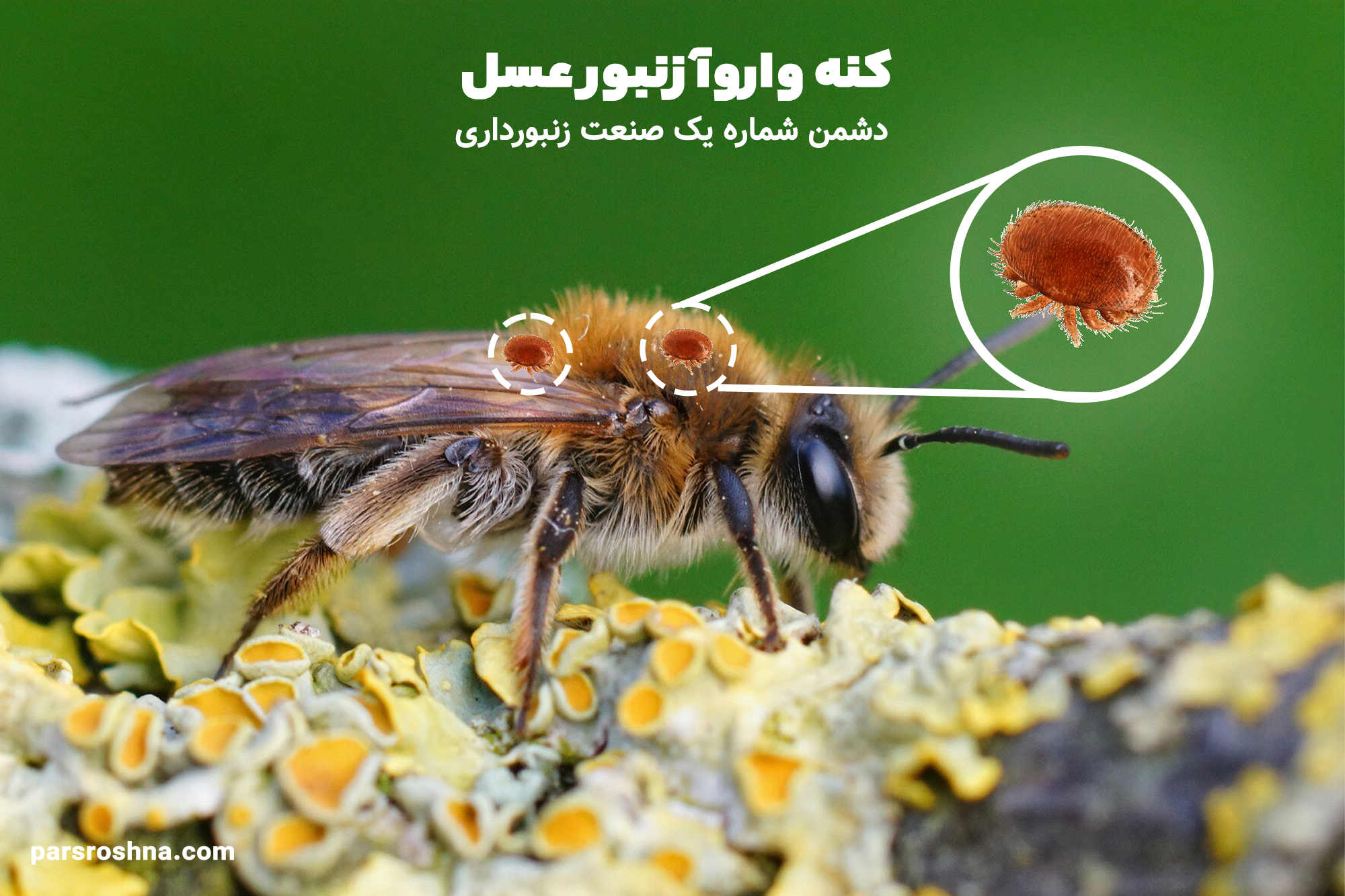Introduction: The beekeeping industry is one of the most important and vital sectors in the world today, which has a great impact on the environment and the global economy. In this industry, honeybees play a very important role; as pollinating birds, bees contribute to the survival of plants and green land cover, and are of great economic importance in the production of honey and related products.
But there are challenges and threats that threaten the health and survival of honeybees, the most important of which is the Varroa mite. The Varroa mite is known as the number one enemy of the global beekeeping industry; this small but deadly mite, by burrowing into the skin of bees, weakens and destroys their colonies. Therefore, improving and optimizing methods to combat the Varroa mite is vital to maintaining the health of honeybees and preserving the honey industry.
In this article, we will examine the challenges and impacts of Varroa mites on the beekeeping and honey industry. We will also examine the importance of optimizing Varroa mite control for the health of bees and the honey industry, and provide strategies for addressing this serious challenge. We hope that this article will serve as a useful guide for beekeepers and those interested in environmental protection and honey production, and will help maintain the health and survival of honeybees.
Varroa mites and their devastating effects on the honey industry
Honeybees, like many other creatures, face problems and threats. One of the biggest threats to honeybees is the Varroa mite. The Varroa mite is a small mite, scientifically known as Varroa destructor, that feeds exclusively on honeybees.
This mite is typically found in sizes ranging from 1 to 2 millimeters and may seem like a small and insignificant creature at first glance, but its devastating effects on honeybees are very serious. In addition to being the main source of honey production, bees play a very important role in the transport of pollen and the supply of agricultural products; therefore, any threat to their health and survival will have widespread effects on the biological and economic world.
Why is the Varroa mite a threat to honeybees?
Varroa mites are known to be a major threat to honey bees for several main reasons, including:
- Parasitism: Varroa mites attack and harm honeybees as parasites. They attach to the bees, dig small holes in their skin, and feed on their blood and tissues, which leads to their weakness and eventual death.
- Disease transmission: In addition to the direct damage that the Varroa mite causes to bees, this mite can transmit viral and bacterial diseases to bees, which can quickly lead to their exhaustion and death.
- Colony Weakening: Varroa mites weaken honey bee colonies and can cause reduced honey production, reduced pollination performance, and ultimately the loss of bee colonies.
Therefore, how to combat this threat to the beekeeping industry and finding ways to prevent Varroa mite infestation is vital to maintaining the health and survival of honeybees and the honey industry.
The effects of Varroa mites on honey bees are as follows:
The Varroa mite affects honey bees in a way that affects a wide range of their activities. As an external parasite, this mite feeds on the fatty tissue of the body of newborn and adult honey bees and is known as the cause of the disease varroosis. Among the activities of this mite can be mentioned its rapid movement between hives and apiaries, which causes its rapid spread.
Varroa mite uses adult bees for transport between hives and feeds on the hemolymph of adult bees to a small extent. However, it uses male bees as its main means of transport, as they move freely between hives. Varroa mite usually inserts itself between the abdominal rings of adult bees and penetrates the membrane between the rings, feeding on the hemolymph and fatty tissue.
The mite makes a relatively large hole in the bee’s cuticle to feed itself and its offspring. The lifespan of a Varroa mite varies depending on the environmental conditions encountered, but can typically range from a few days to several months. The number of mites increases with the bee population, and the rate of reproduction depends on factors such as weather conditions, bee breeds, drug resistance, and the proportion of honeybee brood in the season.
With this expansion and explanation, we can better understand the life cycle of Varroa mites and their effects on honeybee populations and their health.
The life cycle of the Varroa mite includes the following stages:
The Varroa mite life cycle is one of the most important factors that affect the health and sustainability of honey bee colonies. This species of mite is important not only for honey bees but also for the entire local ecosystem. With this in mind, let’s expand on the Varroa mite life cycle and provide more information:
- Cell Entry and Egg Laying: Adult female Varroa mites accidentally enter the brood cells of honey bees, especially those of male brood. Here, they release their eggs into the environment. These eggs are deposited on the walls, the floor of the cell, or even on the larvae. This stage of the life cycle is known as the oviposition stage.
- Larval reproduction and development: The eggs develop into larvae, which are observed in two stages: protonymph and deutonymph. In this stage, the mites take nourishment from the larvae and continue their growth.
- Development to Adult: After the larval stage, the mites mature and emerge from the cell. It takes about 5 to 6 days for males and 7 to 8 days for females to reach adulthood.
- Mating: Mating of mites occurs in the pupae, with the male mite eventually dying inside the cell. This mating process is important for creating genetic and hereditary diversity in the honey bee population.
- Re-egg laying: Young female Varroa mites lay eggs in other brood cells after about two weeks. This process ensures the continuation of the life cycle and evolution of the species.
- Life and Death: Adult mites typically live for up to two months, but they can remain within the sclerites of adult bees and remain active throughout the winter. This life cycle is important because during this time, the mites can serve as food sources for queen cells and adult bees.

The symptoms of a hive being infected with Varroa mites are as follows:
Varroa, as one of the common problems in honey bees, in addition to the direct losses it causes to these insects, has negative effects on the population and health of their colonies. These mites often feed on the fatty tissue of the honey bees’ bodies, thus causing serious damage to the structure of the bees. The baby bees inside the hive cells are also directly affected and may reach maturity incompletely or even die. Symptoms of Varroa include deformation of the bees’ bodies, swelling of their abdomens, and white spots on the baby cells and cell walls. In addition, Varroa can reduce the lifespan of worker bees, disrupt their flight, and reduce the rate of returning to the colony after foraging. Therefore, the diagnosis and prevention of this disease are of great importance to help maintain the population and health of honey bees. A hive infected with Varroa mites may be accompanied by various symptoms.
20 Symptoms of Varroa infestation in a honeybee hive:
- Decline in the bee population: A decrease in the number of bees in the hive may be one of the first signs of a Varroa mite infestation.
- Slow movement or decreased activity: Bees infected with Varroa mites may move more slowly or be less active than before.
- Weak or dead bees: Infected bees usually become weak and may eventually die.
- Presence of infected bees in different locations of the hive: Infected bees may be seen inside the hive, under trees, or even around the hive.
- Bees with weak wings and scales: The wings and scales of bees infected with Varroa mites may appear weak and crushed.
- Changes in bee behavior: Bees infected with Varroa mites may exhibit unusual behaviors, such as incomplete hopping or appearing agitated.
- Presence of brown or red mites on bees: Small brown or red mites may be seen on the bodies of bees; these mites are usually Varroa mites.
- Indicators of infection related to bee scales and tissues: Infected bees may have sores, sensitivity, or changes to the external scales.
- Unusual nectar compositions: Nectar produced by bees may show changes from normal, including a lack or excess of quantity or a change in its color and flavor.
- Presence of injured bees inside the hive: Bees infected with Varroa mites may be inside the hive but appear injured and weak.
- Mucus and other abnormalities not cleared: In some cases, bees infected with Varroa mites may develop mucus and other abnormalities, which could be due to infection.
- Increase in the number of ants: Ants may increase their numbers due to the presence of Varroa mites in the hive.
- Lesions or changes in nectar cells: Changes may be seen in the appearance of the bees and the content of the nectar cells, which may indicate infection.
- Lower honey production: Infected bees usually have lower honey production performance.
- Destruction of nectar cells: In some cases, Varroa mites can attack and destroy nectar cells.
- Failure to clean up waste: Infected bees may not clean up their waste in addition to honey, causing contamination of the hive.
- Changes in social behavior: Infected bees may change their social behavior, including becoming isolated from their group and having fewer social interactions.
- Changes in flight patterns: Infected bees may exhibit changes in their flight patterns, including incomplete or erratic flights.
- Signs of stress and discomfort: Infected bees may show signs of stress and discomfort, including restless and unsteady movements.
- Changes in hive weight: You may want to follow up by weighing the hives; infected bees usually cause the hive to lose weight.
Varroa mite treatment methods:
Varroa mites are known to be a major threat to honey bees, and various methods are used to combat this harmful mite. In this section, we will examine methods for combating Varroa mites using chemical drugs, methods based on plants and natural remedies, and combined and combination methods.
Want to know the best way to treat honeybees from Varroa mites? Read this article: Varroa mite exterminator: Tobacco is the best mite killer for bee hives.
1. Chemical drugs:
The use of chemical drugs is one of the common methods to combat Varroa mites. These drugs usually include compounds such as amitraz, flumethrin, oxalic acid, and thiapiazole. These drugs can effectively control Varroa mites and help the health of honeybees.

2. Methods based on plants and natural medicines:
Varroa mite is one of the most dangerous parasites of honey bees and causes great damage to the beekeeping industry, and so far, many chemical and herbal medicines have been used to control it. In this study, the effect of using medicinal plants, including tobacco extract, pecan extract, thyme extract, tobacco smoke, pecan smoke, and thyme smoke, on this mite was investigated in a total of 21 Langstroth hives in a completely randomized basic design (CRD). The percentage of mite infestation at the beginning and end of the experimental period, as well as the number of mite and worker bee deaths, were determined daily. At the beginning of the experiment, the percentage of mite infestation in the experimental hives did not differ significantly, but at the end of the period, a significant difference was observed between the experimental treatments. Also, a significant difference was observed in the number of mite deaths between the different treatments on the experimental days and the entire period, and tobacco extract showed the greatest effect in mite control. In addition, there was a significant difference in the number of worker bee deaths between different days and the entire experimental period, and the effect of pecan extract was greater in this regard than other treatments.
This study shows that the use of medicinal plants can act as an effective method for controlling Varroa mites in honey bees. In addition, the results show that tobacco extract and pecan extract were the most effective among the treatments studied. This study can be used to develop new and improved methods for combating Varroa mites in honey bees and help maintain the health and survival of honey bees and the beekeeping industry.
(For specialized study, the official source of this article is available on the Iranian Academic Jihad website: Studying the effect of using tobacco, echinacea, and mountain thyme plants in controlling the honey bee mite.)
3. Combined and combination methods:
Combination methods involve combining chemical drugs with natural substances. For example, chemical drugs can be used together with herbal extracts to increase their effectiveness in combating Varroa mites. These methods can effectively help the health of honeybees and also help to preserve the honey industry.
In general, using a variety of methods and combinations to combat Varroa mites can effectively help maintain the health and survival of honeybees and the honey industry. The selection of appropriate methods depends on environmental conditions, the level of contamination, and previous uses, and it is best to consult with beekeeping experts.
Introducing the best available and effective methods for combating Varroa mites:
According to studies and research, the best methods for treating Varroa mites generally include the use of highly effective chemical drugs such as amitraz and flumethrin, along with the use of natural methods such as tobacco extract, thyme extract, and pecan extract. Also, the use of complementary methods can help improve and control Varroa mites.
However, before choosing any treatment method, it is recommended to consult with beekeeping experts and examine the environmental conditions and level of infestation to choose the best possible method for treating Varroa mites and maintaining the health and survival of honeybees.
Honeybee Pest: Varroa and Its Transmission Methods
Varroa is a small external parasite that attaches to the surfaces of honey bees and damages them. Varroa can be transmitted to healthy bees by infected bees or pollinating insects. In addition to this method, there are other methods of transmission of Varroa, which are discussed below.
- Beekeepers may unexpectedly play a significant role in the transmission of Varroa. This can occur when beekeepers use strong colonies to reinforce weak adult bee colonies or when bees are moved from one area to another. Also, the transfer of brood to a new location can occur at the same time as the transfer of Varroa to that area.
- Transmission by predatory bees: Predatory bees may transfer Varroa from weak colonies to strong colonies. This transmission usually occurs during periods of nectar shortage for strong hives.
- Transmission by brood: Brood can carry Varroa to new locations, which may cause it to spread.
- Global Varroa Transmission: The combination of these methods contributes to the global distribution of Varroa as a honey bee pest. This pest reduces the number and health of honey bees worldwide and is a serious threat to the beekeeping industry.
In summary, Varroa mite transmission to healthy bees occurs through various routes, including beekeepers, predatory bees, and brood. These transmissions lead to the global spread of Varroa, and the need for effective strategies to control and prevent this pest is essential.
Fighting Varroa mites in winter:
Winter is one of the times when honeybees are most at risk, as bee activity decreases during this season, and Varroa mites can easily take advantage of these conditions. In this section, we will review important tips and strategies for combating Varroa mites in the winter.
Important tips and tricks:
- Cleaning the hives: In winter, bees hibernate and their activity decreases. Make sure that the Varroa mite does not spread in the hives. It is best to thoroughly clean and disinfect the hives before the cold season begins.
- Use physical protections: Using protections such as physical ovipositors can be effective in preventing Varroa mites from entering hives. Use materials such as wood, foam, and plastic to cover hives.
- Use of special medications: To combat Varroa mites in winter, you can use special medications that are designed for use in cold conditions. These medications can effectively protect against Varroa mites during this season.
- Proper ventilation: Make sure the hives have proper ventilation to reduce humidity inside the hives and prevent an environment that is conducive to Varroa mites.
- Bee Care: In winter, bees need extra care. Make sure the bees are fed with adequate food and proper environmental conditions to help them stay healthy and resistant to Varroa mites.
- Educate beekeepers: Educate beekeepers on how to best combat Varroa mites in winter and use effective methods to maintain the health of honeybees this season.
Overall, fighting Varroa mites in winter requires special care and attention to environmental conditions and bees. By implementing the above tips and strategies, you can effectively protect against Varroa mites this season and improve the beekeeping industry.
Conclusion:
In this article, we have examined and introduced the Varroa mite as one of the serious dangers to honey bees and examined various strategies for combating this harmful mite. The main topic of the article is the importance of maintaining the health of bees and the honey industry, and various strategies for controlling and preventing Varroa mite attacks are introduced.
The importance of the ongoing fight against Varroa mites for maintaining the health of bees and the honey industry is obvious. Honeybees play a very important role in various ecosystems and habitats, and honey is an important and vital product that has great nutritional and therapeutic value for humans. However, a Varroa mite attack can lead to a decrease in honey production, the weakness and death of bees, and even the loss of the honey industry in general.
Therefore, all beekeepers and professionals in this field must pay special attention to the continuous and effective fight against the Varroa mite. By implementing continuous programs to control and prevent the attack of the Varroa mite, it is possible to help maintain the health of bees and the honey industry and prevent the negative effects of this harmful mite. These measures are necessary not only to preserve honeybees but also to preserve biodiversity and protect basic human food products.
Therefore, given the importance of maintaining the health of bees and the honey industry, it is necessary for all stakeholders in this field to make every effort to continuously combat the Varroa mite and use effective and appropriate methods to control and prevent the attack of this harmful mite.











Hi there, just became alert to your blog through Google, and found
that it is really informative. I’m going to watch out for brussels.
I’ll appreciate if you continue this in future. Numerous people will be benefited from your writing.